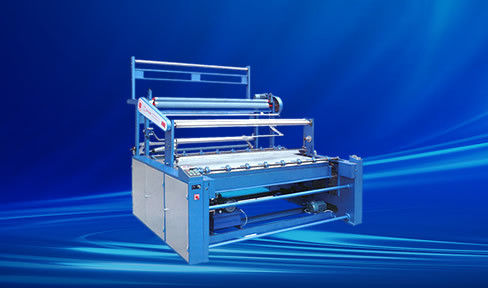Fabric winding mechanism on air jet looms
Release time:
2021-08-30
The role of the winding mechanism is according to the requirements of the weft density of the fabric, the fabric has been woven in a timely and quantitatively lead away from the mouth of the weaving, rolled to the winding roller, so that the position of the mouth of the weaving will not be introduced into the new weft yarns and changes to ensure that the production of weaving can be carried out continuously. 一、卷取机构的分类与工艺要求 1.分类 按运动性质可分为间歇式和连续式两大类。 按传动性质可分为机械式和电子式两大类。 机械间歇式卷取机构,由于它的间歇动作会引起传动件之间产生较大的冲击磨损,所以不被高速织机所采用。在高速的无梭织机上,广泛采用的是机械连续式卷取机构,现在越来越多的喷气织机采用电子式连续卷取机构。 2.卷取的工艺要求 (1)卷取机构应保证按时定长地将形成的织物引离织口,以获得规定纬密的织物,同时将送经机构从织轴上放出的经纱牵引到织物形成区内。 (2)传动运动应准确、平稳、保证纬密均匀,纬密调节快捷简便,调节范围应能满足工艺要求。 (3)卷布辊要轻,便于搬运,卷装要大,以减少落布次数;卷布张力应均匀,布面不得有褶皱,卷布辊装卸要方便。 (4)手动操作要简便、省力。 卷取机构一般由卷取传动、纬密调节、握持牵引、卷绕成形、手动操作、自动计长等几部分组成。 传动路径 供纱侧曲轴—同步齿形带—减速齿轮箱—纬密变换及减速轮系—卷取辊和卷取压辊—卷取辊上的链轮—链条—飞轮—平面摩擦离合器—摩擦轴—卷布辊。 卷绕成形机构:织好的织物在握持牵引机构的作用下引离织口后,在卷绕成形机构作用下按一定张力,规则地被卷绕在卷布辊上。卷绕成形机构由链轮、飞轮、链条、摩擦离合器、卷布辊及布辊夹持座等组成。卷布直径为100~600mm。在卷布过程中,布辊直径逐渐增大,相同布面张力条件下对卷布辊产生的阻力矩也会增大,这就需要随着布辊直径增大而使驱动力矩增大,从而保证驱动力矩能有效驱动卷布辊工作。当布辊直径增大时,机构中的布辊探测板 被推向机后,使摩擦离合器的正压力增加,从而使卷布辊的驱动力矩也随着布辊直径的增大而增大,当驱动力矩大于阻力矩时,布辊随飞轮同步转动;反之,离合器产生打滑现象,布辊的转速慢于飞轮,以此办法保证卷布张力基本恒定的工艺要求。 手动操作机构:是在上经时或织物出现织疵时卷取机构手动卷取或倒转用的,结构简单。 计长装置:机械式十进位计数器,带有定长自动停机功能。根据织物纬密、织机打纬次数,自动计算织物长度。 电子式卷取机构 电子式卷取机构可以与送经机构相结合,在微处理机控制下调整织口位置,以提高织物质量。 电子卷取机构的优点: (1)织物纬密只需在计算机或控制装置键盘上直接设定,不需要更换纬密齿轮,纬密范围大,增强了织物的品种适应性。 (2)在织造过程中可按要求自动变换纬密。这是电子卷取机构最明显、最重要的特点,这一特征,使织机能够生产出变纬密的织物。 机构概要: (1)卷取辊的传动路径:卷取电动机的转动电动机带轮齿形皮带和齿形带轮卷取齿轮箱内蜗杆、蜗轮复合齿轮、复合轴、卷取辊齿轮卷取辊卷取辊以一定速度转动保证了一定纬密。 (2)布的路径与机械卷取相同。 (3)卷布辊的驱动与机械卷取相同:卷取轴上的链轮转动滚子链飞轮卷取张力装置齿轮布辊的驱动。
The role of the winding mechanism is according to the requirements of the weft density of the fabric, the fabric has been woven in a timely and quantitatively lead away from the mouth of the weaving, rolled to the winding roller, so that the position of the mouth of the weaving will not be introduced into the new weft yarns and changes to ensure that the production of weaving can be carried out continuously.
First, the classification of the winding mechanism and process requirements
1. Classification According to the nature of the movement can be divided into two categories of intermittent and continuous.
According to the nature of transmission can be divided into two categories of mechanical and electronic.
Mechanical intermittent winding mechanism, because of its intermittent action will cause a large impact between the transmission parts wear, so is not used by high-speed loom. In the high-speed shuttleless loom, widely used is the mechanical continuous winding mechanism, now more and more air-jet looms using electronic continuous winding mechanism.
2. Winding process requirements
(1) the winding mechanism should ensure that the formation of the fabric at regular intervals to lead away from the weaving mouth, in order to obtain the provisions of the weft density of the fabric, at the same time to send the warp agency from the weaving machine released from the warp yarn traction to the fabric formation area.
(2) Transmission movement should be accurate, smooth, to ensure that the weft density uniformity, weft density adjustment is quick and easy, the adjustment range should be able to meet the process requirements.
(3) The rollers should be light, easy to carry, roll loaded to reduce the number of falling cloth; rolled cloth tension should be uniform, the cloth surface shall not be wrinkled, rolled rollers to facilitate loading and unloading.
(4) manual operation should be simple, labor-saving.
Winding mechanism is generally by the winding drive, weft density adjustment, holding traction, winding forming, manual operation, automatic counting and other parts.
Transmission path Yarn supply side crankshaft - synchronized toothed belt - reduction gear box - weft density change and reduction wheel system - winding rollers and winding pressure roller - sprocket on the winding rollers - chain -Flywheel - Plane friction clutch - Friction shaft - Fabric winding rollers.
Winding and forming mechanism: After the woven fabric is led away from the weaving mouth under the action of the holding and pulling mechanism, it is wound on the winding roller under the action of the winding and forming mechanism according to a certain tension and in a regular manner. The winding and forming mechanism consists of sprocket, flywheel, chain, friction clutch, fabric winding roller and fabric roller clamping seat. The diameter of the cloth roll is 100~600mm, during the process of cloth winding, the diameter of the cloth roll increases gradually, the resistance moment to the cloth roll under the same cloth tension condition will also increase, which needs to be increased with the diameter of the cloth roll to make the driving torque increase, so as to ensure that the driving torque can effectively drive the work of the cloth roll. When the diameter of the cloth roller increases, the cloth roller detection plate in the mechanism is pushed to the back of the machine, so that the positive pressure of the friction clutch increases, so that the driving torque of the cloth roller also increases with the increase of the diameter of the cloth roller, when the driving torque is greater than the resistance torque, the cloth roller rotates with the synchronization of the flywheel; on the other hand, the clutch produces a slipping phenomenon, and the rotational speed of the cloth roller is slower than that of the flywheel, thus ensuring that the cloth is rolled up with the basic requirements of the process of tension constancy.
Manual operation mechanism: is in the upper warp or fabric defects in the fabric when the coiling mechanism manual coiling or reversal with a simple structure.
Counting device: mechanical decimal counter, with a fixed length automatic stop function. According to the weft density of the fabric, the weft of the loom, the number of times, automatic calculation of the length of the fabric.
Electronic winding mechanism
Electronic winding mechanism can be combined with warp feeding mechanism to adjust the weaving mouth position under microprocessor control to improve fabric quality.
Advantages of electronic winding mechanism.
(1) fabric weft density only in the computer or control device keyboard directly set, do not need to replace the weft density gear, weft density range, enhance the adaptability of the fabric varieties.
(2) In the weaving process can be automatically changed according to the requirements of the weft density. This is the most obvious and important feature of the electronic winding mechanism, which enables the loom to produce fabrics with variable weft density.
Outline of the mechanism.
(1) The transmission path of the winding roller: the rotation of the winding motor motor pulley toothed belt and toothed pulley winding gear box worm, worm gear compound gear, compound shaft, winding roller gear winding roller winding roller winding roller rotates at a certain speed to ensure a certain weft density.
(2) The path of cloth is the same as mechanical winding.
(3)The drive of the winding roller is the same as the mechanical winding: the sprocket on the winding shaft rotates the roller chain flywheel winding tension device gears the drive of the cloth roller.
Tag:
Previous article
Next article
Related News

Mobile:
Tel:
Add: Dongshe Town, Tongzhou District, Nantong City, Jiangsu Province
Contact: 86-13901468376 Mr. Zhu
Tel: 86-513-82506284 / 86-513-82506333
Fax: 86-513-82506666
E-mail: sales@ntzhongyi.com
Website: http://www.ntzhongyi.com
HUATAO GROUP
Online Message
Please fill in the form below, our staff will contact you within 24 hours and solve your problem as soon as possible.
Copyright©2024 Nantong Tongzhou Zhongyi Textile Machinery Co., Ltd.






